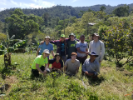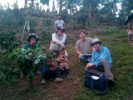Campus News
UB Engineers Without Borders works to bring clean water to Nicaraguan community
By JANE STOYLE WELCH and EMILY SUGARMAN
Published October 19, 2018 This content is archived.
“It was the most beautiful place I have ever been to. From the top of the hills, we could see miles and miles of mountains, trees and coffee bushes,” says Aaron Chaney, secretary of UB Engineers Without Borders (EWB) and a student in the Department of Civil, Structural and Environmental Engineering (CSEE).
Chaney is referring to La Laguna, a community in the central highlands of the Department of Matagalpa in Nicaragua. Located 22 miles from the nearest infrastructural municipalities, the community formed a five-year partnership with UB’s chapter of Engineers Without Borders – USA to work together to provide clean drinking water to La Laguna.
In January, five of the club’s members — Chaney and fellow CSEE students Carlos Abreu and Evan Supple, mechanical engineering students Gavin Amos and Scott Scheers — and UB alumna Rosaleen Nogle (MS ’07, BS ’05, Civil Engineering, and BA Anthropology ’05), an assistant principal engineer with the Buffalo Sewer Authority, traveled to La Laguna to visit their partner community for the first time and evaluate the situation.
Once there, they discovered they would face some unexpected challenges.
“The team observed that there were about 50 homes. They were not clustered together in a typical village, but rather spread over almost nine square miles of rainforest, mountains and quick sand connected only by dirt walking paths. The village had over 250 residents and over two-thirds of the children were sickened annually by contaminated drinking water,” Nogle says.
The team conducted an initial assessment to better understand how to design an effective and sustainable solution to La Laguna’s water issue. Team members tested the water source for bacteria and heavy metals to determine the type of filter to use, measured elevation changes so they could design a distribution system and determined the type of piping to use.
Another constraint was that they had to use materials that were readily available so the villagers could maintain the system and fix any future damage themselves.
“The biggest thing that caught my attention was that the people lived without all the technology and advancements that we have here in the U.S.,” Abreu says. “I’ve learned how much I’ve taken for granted. The atmosphere is much more relaxed, which probably contributes to a healthier mind and soul.”
None of the community members were proficient in English, and Abreu was the only EWB member fluent in Spanish, so in addition to cultural differences, miscommunication was a potential issue. But the team overcame communication challenges with creativity and patience.
“By the end of the week, the participants had learned some of each other’s languages and we all learned valuable lessons regarding non-verbal communication and the necessity of observation in order to design, construct and maintain an engineering project,” Nogle says.
She was inspired to participate in the project by an interest in serving disadvantaged communities and in helping develop future engineers. She has worked to address issues of inadequate access to proper sanitation and drinking water in the most rural parts of Erie County and in the city of Buffalo through her work for the Erie County Division of Sewerage Management, Erie County Health Department, and now the Buffalo Sewer Authority.
“Over and over again, I have heard criticism directed toward engineers that they don’t respect the expertise of end users; that engineers design infrastructure that is not constructible or that once constructed is not usable. In being offered the opportunity to work with these engineering students, I saw a way to help remedy this situation moving forward,” Nogle says.
Back in Buffalo, the team is continuing to work on the design of the system. The project is multi-dimensional, and requires a variety of skillsets and specialized knowledge.
“I am a biomedical engineering major,” says past EWB president Erin Maloney, “whereas other members of the club are environmental, civil and mechanical engineers, and computer science majors. Each person brings a different perspective to the venture. This kind of collaboration is more similar to the workplace than a typical academic project.”
The club plans to return to La Laguna next spring to work on the project. They plan to install a pipeline and basin system that provides filtration, chlorination and central distribution — sourced from a year-round flowing mountain stream that is dammed approximately half a mile from the center of La Laguna.
“I believe what is special about EWB is that even though we work on a project utilizing our skills like other engineering clubs, we are not just working on this project for a competition; we are actually going to impact the lives of over 250 people by providing them with clean drinking water,” Maloney says.







